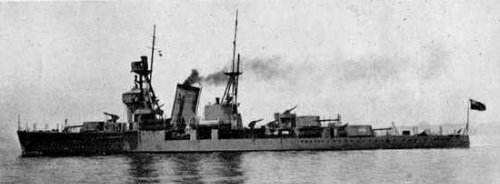
NAVYPEDIA
 Support the project with paypal
Support the project with paypal
Photo

Ning Hai 1932
Ships
| Name | No | Yard No | Builder | Laid down | Launched | Comp | Fate |
|---|---|---|---|---|---|---|---|
| 甯海 [Ning Hai] | Harima Zosensho, Aoi, Japan | 20.2.1931 | 10.10.1931 | 31.7.1932 | sunk 23.9.1937 | ||
| 平海 [Ping Hai] | Kyangnan DYd, Shanghai // Harima Zosensho, Aoi, Japan | 28.6.1931 | 29.9.1935 | 1/1937 | sunk 25.9.1937 |
Technical data
| Displacement standard, t |
|
|---|---|
| Displacement full, t | Ning Hai: 2526 Ping Hai: 2448 |
| Length, m | 100.6 pp 108.2 wl 109.7 oa |
| Breadth, m | 11.9 |
| Draught, m | Ning Hai: 4.04 Ping Hai: 4.00 |
| No of shafts | Ning Hai: 3 Ping Hai: 2 |
| Machinery | Ning Hai: 3 VTE, 4 Kampon boilers Ping Hai: 2 VTE, 4 Kampon boilers |
| Power, h. p. | Ning Hai: 10500 Ping Hai: 7400 |
| Max speed, kts | Ning Hai: 23 Ping Hai: 21 |
| Fuel, t | coal 600 + oil 110 |
| Endurance, nm(kts) | 5000(12) |
| Armour, mm | belt: 76 - 25, deck: 25 - 19, turrets: 25, CT: 25 |
| Armament | Ning Hai: 3 x 2 - 140/50 3-shiki, 6 x 1 - 76/40 3-shiki, 8 x 1 - 7.7/87, 2 x 2 - 533 TT, 2 seaplanes (really 1 Aichi AB-3) Ping Hai: 3 x 2 - 140/50 3-shiki, 3 x 1 - 76/40 3-shiki, 4 x 1 - 7.7/87, 2 x 2 - 533 TT |
| Complement | Ning Hai: 361 Ping Hai: 340 |
Standard scale images

Ning Hai 1932

Ping Hai 1937
Graphics
Project history
Smallest cruisers built between world wars, actually large gunboats or sloops, however having all signs of cruiser under international treaties: more than 2000t displacement, more than 20kts speed, larger than 130mm calibre of main guns. The design history has begun in 1929 when Chinese Naval Ministry appealed to shipbuilders of Great Britain, USA, Germany and Japan with a proposal about possibility of building of small light cruisers. Design of Japanese "Harima Zosensho" was chosen, and 5.12.1930 contract on building of lead Ning Hai was concluded. Building of Ping Hai was conducted in China with technical assistance of Japan (since August, 1934 50 Japanese experts was headed by director of "Harima"), and since 30.10.1935 till 18.6.1936 cruiser was outfitted in Japan on "Harima".
Chinese cruisers were developed on the basis of design of Japanese cruiser Yubari, though had significant differences in appearance, armament arrangement and protection scheme. Armament under the design consisted from 3 twin 140mm/50 "type 3" guns, similar to installed on all Japanese light cruisers built in 1920s, thus turrets were identical to installed on Yubari. Turrets took places on "retreat" scheme: one on forecastle, two aft. Design provided 2 Aichi AB-3 seaplanes (including one in covered hangar; actually only one AB-3 was delivered from Japan to China), however without catapults. Machinery consisted of 4 water-tube "Kampon" boilers (15.5atm working pressure) and 3 vertical 4-cylinder VTEs on 3500hp each. All machinery was made by "Mitsubishi". Using of archaic steam engines instead of conventional turbines was caused by low crew qualification though became a step back in comparison with previous Chinese cruisers of the 1910 program. Boilers placed in four separated rooms, and two boilers in fwd rooms used a coal, and two boilers in aft rooms were oil-firing. Engines placed in two rooms: side-shaft engines in fwd and, central-shaft in aft. On trials 24.5.1932 Ning Hai reached 22.207kts at 10579hp. Trials of lead cruiser revealed serious problems with stability, peculiar to all Japanese ships of that period and acknowledged 12.3.1934 by incident with Tomozuru. As result, during outfitting of Ping Hai a number of measures directed on improvement of stability, however worsened "battle" qualities of ship were accepted. In particular, superstructures were moderated, massive tripod foremast with fire control position was replaced by lighter, hangar and aviation were liquidated, number of 76mm AA guns and 7.7mm MGs was shrunk in twice, TTs were not installed (according to some information, TTs were replaced also from Ning Hai). Main changes concerned machinery: central shaft and one boiler were removed, and on their place the lead ballast was laid, so formally sister-ships had different number of shafts. On trials Ping Hai has shown 21.256kts at 7488hp.
Ship protection
25mm main belt protected onlyt machinery compartments. It was connected with an upper deck and had 3.35m height. Fwd and aft from it there was 76mm narrower strake (1.52m height), protecting magazines, its upper edge was above, and lower edge below than lower edge of main belt. Armour deck was flat. Over machinery it placed at level of an upper deck and had 19mm thickness, over magazines it was at upper platform level and had 25mm thickness. Turrets and a conning tower from all directions were protected by 25mm armour.
Modernizations
None.
Naval service
Ning Hai arrived to Shanghai 26.8.1932. 23.9.1937 she was damaged by aircrafts from Japanese carrier Kaga and was sunk on shallow water on Yangtze river at Jiangyin, 5.12.1937 she was captured by Japanese army, salvaged by Japanese in April, 1938 and in 1944 was commissioned by IJN as Ioshima; she was sunk 10.10.1944 by American submarine Shad at Honshu. Ping Hai 23.9.1937 was damaged by aircraft from Japanese carrier Kaga, 25.9.1937 was sunk by aircraft from Kaga on shallow water on Yangtze river at Jiangyin; 5.12.37 she was captured by Japanese army, salvaged and in 1944 was commissioned by IJN as Yasoshima; she was sunk by American carrier aircraft at Luzon (Philippines) 25.11.1944. Wreck was raised in 1947, returned to China and was used there as mooring float.
© Ivan Gogin, 2011-14
 HOME
HOME FIGHTING SHIPS OF THE WORLD
FIGHTING SHIPS OF THE WORLD CHINA
CHINA CRUISERS
CRUISERS NING HAI small light cruisers (1932-1937)
NING HAI small light cruisers (1932-1937)
